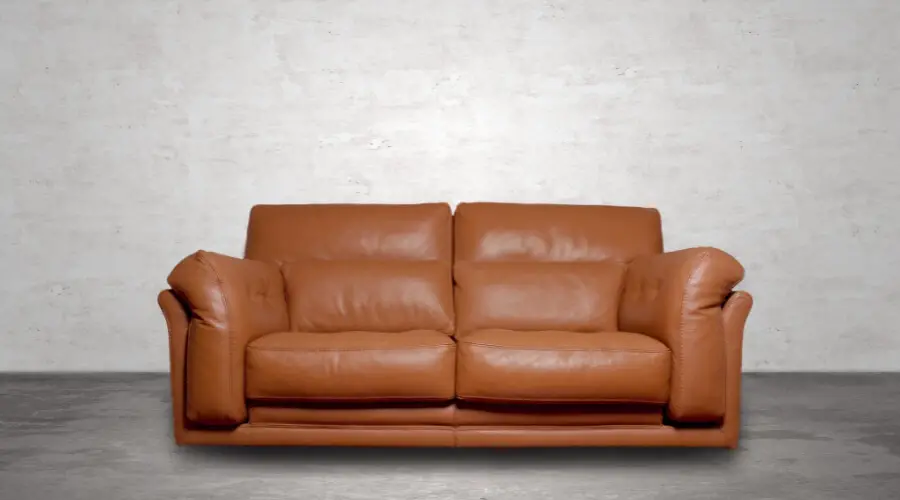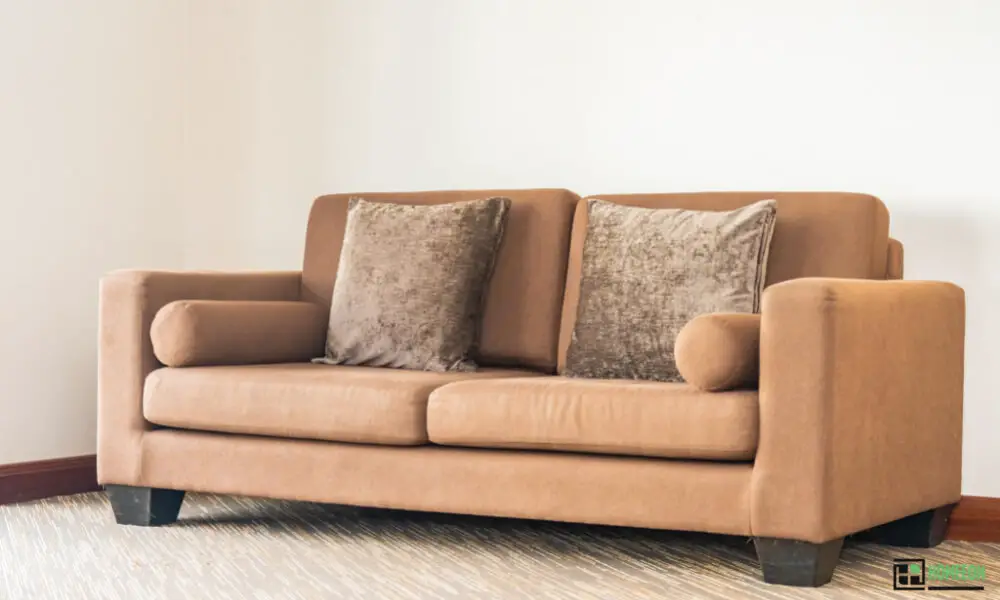Last Updated on July 13, 2023 By Emma W. Thomas
Leather suede sofas have both pros and cons to consider. On the positive side, they offer a luxurious and stylish look, adding sophistication to any space. Leather suede is also durable and resistant to stains, making it easy to clean and maintain. Additionally, these sofas tend to be comfortable and soft to the touch. However, leather suede can be more expensive than other materials, and it may require regular conditioning to prevent drying and cracking. It is also susceptible to scratches and fading over time.
Pros Of Leather Suede Sofas

Several pros come with leather suede sofas. These including;
1. Less Expensive Yet You Get Leather-Look In Your House
Certain types of leather sofas are generally expensive. But, leather suede tends to be less costly as it sacrifices durability. Nonetheless, it is still a product of hiding and thus will serve you for a reasonable time while allowing you to enjoy a leather look in your living room.
2. More Comfortable As It Tends To Be Softer
Leather suede sofas are soft and pliable and therefore are comfortable. However, the quality of suede used on the sofa determines the comfort level. For instance, high-quality sofas made of ultra-suede material and filled with premium sponges are more comfortable. Plus, they do not wrinkle or get loose when you stand.
Cons Of Leather Suede Sofas
Despite the pros that come with leather suedes sofas, they have drawbacks that you should consider before buying your furniture. The cons include:
1. Prone To Damage
Suede leather is made from the underside of younger animal skins. As a result, they tend to be thin and soft, which is a plus to many. However, it makes your sofas prone to damage, meaning they won’t serve you long enough as other types of leather.
2. Absorbs Water
Liquid spillage is common in many homes, especially with kids around. This can be bad if you have leather suede sofas as it doesn’t repel water.
Leather suede features a brushed and raised finish, which makes your sofas absorb liquid easily due to the porous nature of the material. If the liquid is not water, for instance, milk or juice, it can stain and ruin the brushed finish of your couch.
Therefore, it will necessitate a lot of care to keep the sofas in good shape. You will need to invest in a protective spray to treat suede. This creates a protective barrier against liquid damage but adds to the cost of maintenance as sofas should be treated regularly.
3. Stains Easily
Unlike genuine leather that can stand up to many stains, suede sofas stain more. You will thus need to do special cleaning regularly or use a protective covering which adds to the overall maintenance cost. You will also need to regularly vacuum to remove surface dust and dirt.
Are Leather Suede Sofas Hard To Clean?

Unlike leather, suede sofas are difficult to maintain as they tend to absorb water and stain easily. However, that doesn’t mean it cannot be cleaned at all. You can remove stains from your leather suede without much drama with a few tips and effort.
5 Tips For Cleaning Leather Suede Sofas
Follow the tips below to keep your suede sofa clean:
1. Refresh Your Sofas
If your furniture is a bit dirty, it would be best to freshen it up before you think of using a stain remover. Simply take a moist cloth and use it to wipe the surface of your sofa to remove the dust and dirt without getting it wet. Do this regularly to avoid a lot of dust accumulating and making your couches filthy.
2. Use A Suede Stain Remover To Get Rid Of Any Blemish On Any Part Of The Couch
When you have suede sofas, it is advisable to buy a specialist cleaning product meant for the material. But, before you start to use the product on your couch, test it in a hidden area for at least 20 minutes to ensure it won’t damage your furniture. Once you are sure the product is safe, apply the stain remover as per the manufacturer’s guide.
Alternatively, you can use white distilled vinegar mixed with water if you do not have the specialist suede stain remover. Again, test the mixture in inconspicuous spots first.
Regardless of the stain remover you opt for, always dry the affected areas after getting rid of the blemishes.
3. Act Fast On Wet Stains
Leather suede absorbs water easily, and any spill can damage your sofas. So, if you spill drinks or food onto your suede sofas, work on it really fast.
Gently blot the affected area to soak up as much liquid and stain as possible. You can also blot any residue using a damp cloth. If some blemish is left, apply the stain treatment immediately as per the manufacturer’s guide, let it sit for a few minutes, and then rinse it off using a clean damp cloth. You can also dry the area using a hairdryer.
4. Use Suede Cleaning Block Or Rubber Eraser To Treat Old Stains
Rub the spot gently using a suede cleaning block or a rubber eraser if you notice old stains on your suede sofas. Once the area is stain-free, use a soft brush to get rid of any remaining dirt but in case of hard-to-shift stains like those of crayon and ink, contact expert leather cleaning agencies for help.
5. Brush Your Suede Sofas Regularly
It would help if you kept your suede sofas looking spotless by gently brushing them regularly. This is a good practice, especially if you have dogs and cats around. But, before you brush, remove any stains and spills. Leave the area to dry well, and use a soft suede brush to brush your sofas in gentle circular motions.
5 Reasons Why Suede Leather is Perfect for Sofas
When it comes to choosing the right material for your sofa, suede leather is often an excellent choice. Suede leather is known for its luxurious feel and distinctive appearance, making it a popular option for homeowners seeking a stylish and comfortable seating solution. If you’re considering investing in a suede leather sofa, here are five reasons why it’s a great option:
- Luxurious and Soft Texture:
One of the main reasons why suede leather is so popular for sofas is its luxurious and soft texture. Suede leather is made from the underside of the animal hide, giving it a velvety feel that is gentle to the touch. This plush texture adds an element of sophistication and comfort to your living space, ensuring a cozy seating experience every time you sit on your sofa.
- Timeless and Elegant Look:
Suede leather sofas have a timeless and elegant look that never goes out of style. The natural variations and markings in suede leather create a unique and sophisticated appearance, adding character and depth to your living room. Whether you prefer a classic or contemporary interior style, a suede leather sofa will effortlessly elevate the aesthetic appeal of your space.
- Durable and Resilient:
Contrary to popular belief, suede leather is highly durable and resilient. It can withstand heavy everyday use and remains in excellent condition for years to come. The natural fibers in suede leather make it resistant to tears and punctures, while its thick and strong structure ensures robustness and longevity. With proper care and maintenance, your suede leather sofa can retain its beauty and quality for a long time.
- Versatile and Compatible:
Suede leather is a versatile material that effortlessly complements various home decor styles. It’s neutral tones and earthy colors blend seamlessly with different color schemes, allowing you to easily coordinate your sofa with the rest of your furniture and accessories. Whether you have a rustic country theme or a sleek modern design, a suede leather sofa adds a touch of warmth and sophistication to any space.
- Practical and Easy to Clean:
Despite its reputation for being high maintenance, suede leather can be practical and easy to clean if you follow the right cleaning and maintenance practices. Regular vacuuming with a soft brush attachment can help remove dust and debris, while spills and stains can be addressed with mild soapy water or specially formulated suede leather cleaners. It’s essential to always test any cleaning solution on an inconspicuous area first to avoid potential damage.
How Do You Get The Urine Smell Out Of Leather Suede Sofas?
If a pet urinates on your leather suede sofa, it will leave it with a stain and a strong odor. So, first, you will need to remove the stain and then tackle the odor.
Add mild soap to lukewarm water in a bucket and stir the mixture until you get a good amount of suds on top. Apply the suds on stained spots using a sponge and blot the area to eliminate the blemish. Take a damp cloth and continue blotting the area to remove all the soap. Once the area is clean with no soap residue, dry it with a clean, soft cloth or a hairdryer.
Once you deal with the stain, it is time to tackle the odor. Sprinkle the area with baking soda or baby powder and let it sit on the affected spot overnight. Vacuum the sprinkled area the next day to remove the powder, and your suede sofa will be odorless.
Alternatively, you can use vinegar to tackle the odor. Lightly moisten a clean cloth with vinegar and use it to wipe the affected area. Give it time to dry. The vinegar smell will fade off as the sofa dries and remove the odor.
N/B: Leather suede is sensitive to some cleaning agents and different amounts of liquid. If you have never used the products on your suede sofas, test them in hidden spots before applying them to large areas.
Can You Clean A Leather Suede Sofa With Soap And Water?
You need to check the care tag on your sofa to know whether or not you can clean it with soap and water. If your sofa has a W or W-S care tag, you can clean it with soap and water. Those with Scare tags cannot be cleaned with soap and water, and you should always use rubbing alcohol.
However, regardless of the care tag, you can always vacuum them at least weekly to remove dust and dirt, treat stains promptly and clean them thoroughly bi-yearly.
Final Thoughts!
Leather suede can be used on sofas as it tends to be soft, comfortable, and reasonably durable. However, if you opt for this type of sofa, be ready to deal with stains, spillage, and repairs due to damages.
And although all these issues make maintenance of leather suede sofas difficult, it is possible to keep them clean. Use the tips we have highlighted to keep your furniture stain-free and apply baking soda, baby powder, or vinegar in case of odor.
References:
https://www.masterclass.com/articles/leather-vs-fabric-sofa-explained
https://toronto.citynews.ca/2004/02/03/suede-and-leather-lesson/
Emma is a graduate of Domestic Science or Family and Consumer Sciences (Home Economics) from the University of Wisconsin. She has 7 years of experience Working with the strategic section of BestBuy and now writing full-time for Homeeon.
From Managing the Home, Interiors, Cleaning, and Exteriors to Gardening and everything about Making A Home Liveable – is her passion and this Homeeon is the result of this.
Emma loves decorating her home with the best stuff found online. She cares about quality over anything and writes reviews about them here in Homeeon. Get in touch with her over Pinterest.
Keep reading her blogs.

